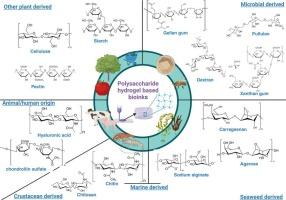用于生物医学应用的三维生物打印多糖水凝胶的最新进展:全面综述
IF 10.7
1区 化学
Q1 CHEMISTRY, APPLIED
引用次数: 0
摘要
多糖水凝胶可模仿天然细胞外基质,具有诱人的物理化学和生物学特性,已成为三维生物打印的重要生物材料。由于它们能以类似于自然细胞环境的方式增强细胞粘附、增殖和分化,因此在组织工程和再生医学领域的应用前景非常广阔。本综述全面探讨了多糖水凝胶驱动的三维生物打印的制造方法、特点和应用,强调了其在组织工程、药物输送和再生医学方面的潜力。为了为这一领域的未来研究贡献相关知识,本综述对关键方面进行了严格审查,包括碳水化合物的化学性质、制造技术、生物墨水的配制以及多糖基水凝胶的表征。此外,本综述还探讨了三维打印多糖水凝胶的主要进展和应用,包括具有控释动力学和靶向治疗功能的给药系统,以及用于骨骼、软骨、皮肤和血管再生的组织工程结构。此外,还探讨了这些三维生物打印水凝胶在疾病建模和药物筛选等创新研究领域的应用。尽管取得了显著进展,但挑战也很突出,包括调节多糖的化学性质和特性、提高生物墨水的可印刷性和机械特性,以及实现长期的体内稳定性。本文章由计算机程序翻译,如有差异,请以英文原文为准。

Recent advances in 3D bioprinted polysaccharide hydrogels for biomedical applications: A comprehensive review
Polysaccharide hydrogels, which can mimic the natural extracellular matrix and possess appealing physicochemical and biological characteristics, have emerged as significant bioinks for 3D bioprinting. They are highly promising for applications in tissue engineering and regenerative medicine because of their ability to enhance cell adhesion, proliferation, and differentiation in a manner akin to the natural cellular environment. This review comprehensively examines the fabrication methods, characteristics, and applications of polysaccharide hydrogel-driven 3D bioprinting, underscoring its potential in tissue engineering, drug delivery, and regenerative medicine. To contribute pertinent knowledge for future research in this field, this review critically examines key aspects, including the chemistry of carbohydrates, manufacturing techniques, formulation of bioinks, and characterization of polysaccharide-based hydrogels. Furthermore, this review explores the primary advancements and applications of 3D-printed polysaccharide hydrogels, encompassing drug delivery systems with controlled release kinetics and targeted therapy, along with tissue-engineered constructs for bone, cartilage, skin, and vascular regeneration. The use of these 3D bioprinted hydrogels in innovative research fields, including disease modeling and drug screening, is also addressed. Despite notable progress, challenges, including modulating the chemistry and properties of polysaccharides, enhancing bioink printability and mechanical properties, and achieving long-term in vivo stability, have been highlighted.
求助全文
通过发布文献求助,成功后即可免费获取论文全文。
去求助
来源期刊

Carbohydrate Polymers
化学-高分子科学
CiteScore
22.40
自引率
8.00%
发文量
1286
审稿时长
47 days
期刊介绍:
Carbohydrate Polymers stands as a prominent journal in the glycoscience field, dedicated to exploring and harnessing the potential of polysaccharides with applications spanning bioenergy, bioplastics, biomaterials, biorefining, chemistry, drug delivery, food, health, nanotechnology, packaging, paper, pharmaceuticals, medicine, oil recovery, textiles, tissue engineering, wood, and various aspects of glycoscience.
The journal emphasizes the central role of well-characterized carbohydrate polymers, highlighting their significance as the primary focus rather than a peripheral topic. Each paper must prominently feature at least one named carbohydrate polymer, evident in both citation and title, with a commitment to innovative research that advances scientific knowledge.
 求助内容:
求助内容: 应助结果提醒方式:
应助结果提醒方式:


